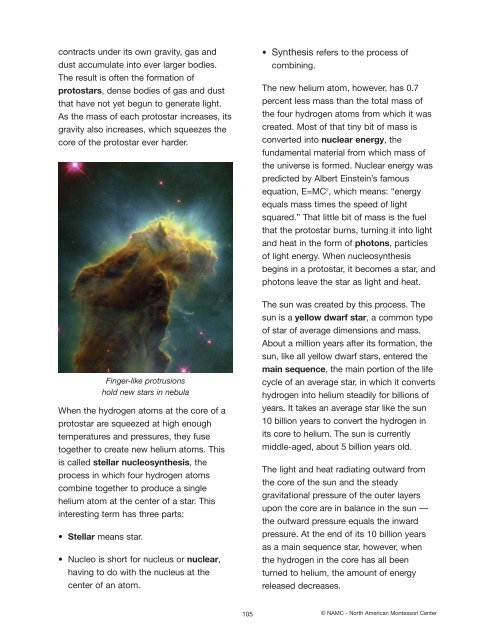THE LIFE CYCLE OF STARS - Montessori Training
THE LIFE CYCLE OF STARS - Montessori Training
THE LIFE CYCLE OF STARS - Montessori Training
You also want an ePaper? Increase the reach of your titles
YUMPU automatically turns print PDFs into web optimized ePapers that Google loves.
contracts under its own gravity, gas anddust accumulate into ever larger bodies.The result is often the formation ofprotostars, dense bodies of gas and dustthat have not yet begun to generate light.As the mass of each protostar increases, itsgravity also increases, which squeezes thecore of the protostar ever harder.Finger-like protrusionshold new stars in nebulaWhen the hydrogen atoms at the core of aprotostar are squeezed at high enoughtemperatures and pressures, they fusetogether to create new helium atoms. Thisis called stellar nucleosynthesis, theprocess in which four hydrogen atomscombine together to produce a singlehelium atom at the center of a star. Thisinteresting term has three parts:• Stellar means star.• Nucleo is short for nucleus or nuclear,having to do with the nucleus at thecenter of an atom.• Synthesis refers to the process ofcombining.The new helium atom, however, has 0.7percent less mass than the total mass ofthe four hydrogen atoms from which it wascreated. Most of that tiny bit of mass isconverted into nuclear energy, thefundamental material from which mass ofthe universe is formed. Nuclear energy waspredicted by Albert Einstein’s famousequation, E=MC 2 , which means: “energyequals mass times the speed of lightsquared.” That little bit of mass is the fuelthat the protostar burns, turning it into lightand heat in the form of photons, particlesof light energy. When nucleosynthesisbegins in a protostar, it becomes a star, andphotons leave the star as light and heat.The sun was created by this process. Thesun is a yellow dwarf star, a common typeof star of average dimensions and mass.About a million years after its formation, thesun, like all yellow dwarf stars, entered themain sequence, the main portion of the lifecycle of an average star, in which it convertshydrogen into helium steadily for billions ofyears. It takes an average star like the sun10 billion years to convert the hydrogen inits core to helium. The sun is currentlymiddle-aged, about 5 billion years old.The light and heat radiating outward fromthe core of the sun and the steadygravitational pressure of the outer layersupon the core are in balance in the sun —the outward pressure equals the inwardpressure. At the end of its 10 billion yearsas a main sequence star, however, whenthe hydrogen in the core has all beenturned to helium, the amount of energyreleased decreases.105 © NAMC - North American <strong>Montessori</strong> Center



